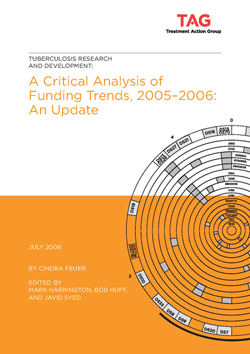A Critical Analysis of Funding Trends, 2005–2006: An Update
By Cindra Feuer
July 2008 – The Treatment Action Group (TAG) report on tuberculosis (TB) research and development (R&D) in 2006 finds that while funding for TB research increased from 2005 it fell far short of the need. The report also finds that although funding from philanthropic sources rapidly increased from 2005 to 2006, public sector spending did not keep up; the proportion of total investment derived from public sources actually declined in 2006. The increased investment in new diagnostics, drugs, and vaccines is welcomed but nowhere near levels needed according to the Global Plan to Stop TB: 2006-2015, which estimated that $900 million per year would be required to advance this research. TAG’s report shows that in 2006, only $429 million was spent on all TB R&D (including basic science and operational research, two categories not addressed by the Global Plan), leaving almost a $500 million gap. Indeed, TAG has estimated that $2 billion per year may be actually required to support the full gamut of needed TB R&D. This $2 billion figure includes TAG’s estimates for basic science and operational research in addition to the amount needed for diagnostics, drugs, and vaccines according to the Global Plan.
That the world is falling short of the Global Plan’s targets is depressing but not surprising news. After being unveiled with great fanfare in January 2006, the Global Plan has received only nominal support from many key countries, despite being endorsed by the UN General Assembly at the UNGASS review in June 2006 and by the World Health Assembly in May 2007. Many governments, in fact, are failing to adhere to their promises on TB, on universal access to HIV prevention, care, and treatment by 2010, and on many other aspects of global public health.
For TB research and development, comprehensive tracking of investments will continue to be vital to assess the gaps and measure our success in meeting the challenge of mobilizing the $2 billion a year needed for the research to assure that the necessary tools are developed and made accessible.

